Henschel Hs-123: a primitive but "indestructible" German attack aircraft
Maybe for the Russian reader it may seem a little offensive, but the United States for most of the 20 century was the leading country in the field of aircraft manufacturing. And at the dawn of the 1930-ies, it was the Americans who made the first experiments in the area of dive bomber with attack plane functions, although the first attack biplanes appeared in World War One. German aircraft designers adopted valuable transatlantic experience and, combining it with their own developments of the First World War and American investments, began to actively cooperate with officers just starting the formation of air forces of Nazi Germany, proposing to use these types of airplanes in the coming war. This concept was approved, and one of the first machines created for its implementation was the Hs-123, the first prototype of which took off on 1 on April 1935 of the year.
The Luftwaffe functionaries liked the plane (one of the leaders of the Third Reich Air Force, the famous ace of the First World War, Ernst Udet, personally flew around the new car) and was given the go-ahead for a small pre-production release. The production of the first German attack aircraft was carried out at the Henschel factories in Schoenefold and Johannastall, as well as at the AGO plant in Aschersleben.
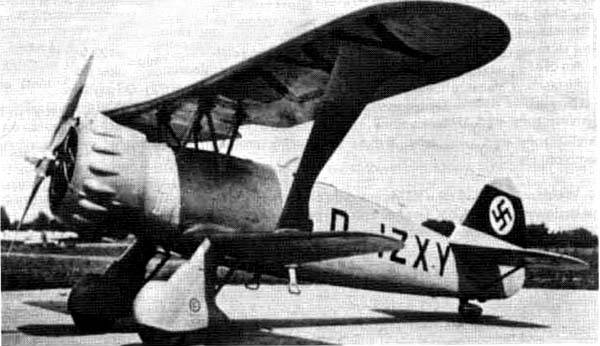
This plane, like many 1930-x machines, combined both old and new design features designed to enhance its combat survivability and realize its combat functions. First, it was a seemingly outdated biplane (one of the last German planes of this scheme), but this gave, in combination with good aerodynamics, very good controllability and horizontal maneuverability (and, as we know, for the attack aircraft, high speeds very important).
Secondly, he had a large, not retractable landing gear, closed by fairing. This, of course, could not but reduce the speed data, but in part this was exactly what gave (like the famous Ju-87) the opportunity to get out of an almost steep dive without a catastrophic speed increase. In general, it can be noted that this aircraft was similar to the Soviet I-15 and I-153, which, although created as fighters, but by and large at the end of 30-s were used as attack aircraft. At the same time, we emphasize that the Hs-123 was originally created as a diving bomber and attack aircraft, which led to its greater efficiency.
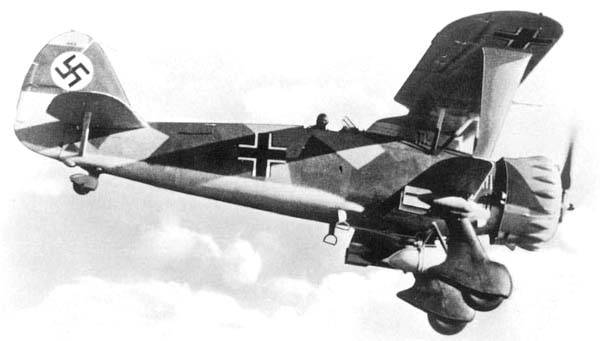
Thirdly, the considered German aircraft was all-metal - both the wings and the fuselage were made of aluminum, and the design itself was further strengthened (and in this it was radically different from the Soviet machines of the time). This gave him a very large margin of safety and combat survivability, since if, for example, a small hole remained in the wing of the dural plane, for example. At the same time, in the case of a projectile hit the wing, made of "linen and cardboard", etc. materials that were traditional for the Soviet aircraft industry at that time, a hole that grew in flight was formed in the plane, which often led to a serious violation of aerodynamics and even a broken wing and, accordingly, a catastrophe. Therefore, the all-metal airframe itself was a huge and vital plus for the attack aircraft (recall that the famous IL-2 was, in general, a half-wooden plane, and a significant proportion of the knocked down cars were those who had a plane broken in flight as a result of hits. or tail fell off).
Fourthly, the all-metal construction is much better able to withstand flight loads and is an order of magnitude more resistant to weather effects (this is largely, for example, determined by the catastrophically small number of surviving Soviet aircraft of pre-war time).
And of course, from the very beginning, Hs-123 had radio stations FuG 7, which facilitated the coordination of their actions by both ground-based aircraft operators and control stations. Also, German pilots noted both the convenient location of the cockpit itself in the Hs-123 and the convenience of viewing from it (the pilot's seat had an adjustment system). The lower wing of the machine had a single-spar construction, and flaps were located along its trailing edge. The upper wing was large in size and had a two-spar design.
Although the steering was not automated, as on many German aircraft already then, it still had weight compensation, and therefore the Hs-123 was considered fairly easy to control in flight.
Fifthly, the majority of the Hs-123 had a BMW132 star-shaped air-cooled engine (horsepower 880), which was covered with a hood with characteristic pins for cylinder heads. Of course, this again reduced speed data somewhat (the maximum speed of this car was 340 km / h) and blocked the pilot's view ahead. But we recall that the speed data of such aircraft, later created and becoming a kind of WWII symbols, of airplanes like Ju-87 and Il-2, was not much higher, and the Luftwaffe fighter fighter, at the beginning-middle of the year, had the same speed. The cockpit in the Hs-30 was raised and was in the highest part of the fuselage, which allowed partly to eliminate the problem of the review ahead. At the same time, the star-shaped air-cooled air-cooling engine, which is very reliable and resistant to combat damage, was an excellent front protection for the pilot, which is important for assault attacks (recall that one of the main problems affecting the vitality of the Ju-123 and Il-87 was liquid cooling engines).
Thus, despite the apparent primitivism of the design, in the hands of the German pilots of the prewar time and the initial period of WWII, there was a very persistent, hard-to-break and well-controlled combat aircraft. A certain disadvantage of the Hs-123 was its weak armament - only 2 fuselage, synchronized with a propeller, 7.9 caliber mm MG-17 machine gun, as well as a small bomb load (up to 250 kg., With overload up to 450 kg. Bombs). However, in general, such weapons were considered, in general, good for the middle 1930-x.
In order to strengthen it, the German designers developed special underwing containers, thanks to which the Hs-123 could additionally be equipped with 2 machine guns (or rifle caliber, or large-caliber) before the pilot's choice, while the departure could be carried out with a load of bombs. A little later, from the 1938 of the year, the German pilot could also choose additional weapons in the form of two underwing 20-mm MG-FF cannons, which made it possible to seriously increase the firepower of this attack aircraft (recall that the IL-2 offensive weapons also consisted of two machine guns and two 23-mm guns), however, in this case, the combat mission was usually carried out without a bomb load.
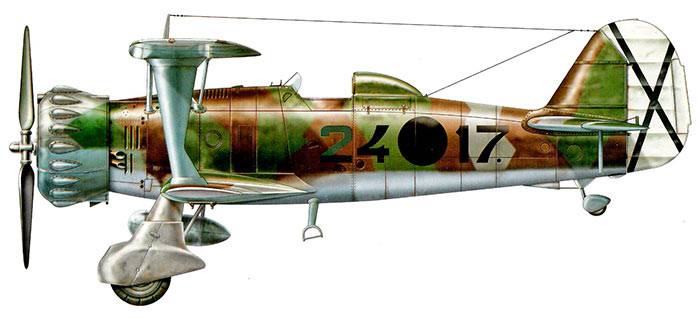
Thus, it was Hs-123 that was one of the main competitors of Ju-87, and from a military point of view it showed itself well as part of the Condor Legion in Spain, having received there the ironically conventional name Angelito - Angel.
The first link of these aircraft in the composition of the three cars arrived in Spain in the autumn of 1936, and from that moment Hs-123 went through the entire Civil War on the Iberian Peninsula, and at first they were used even as fighters. True, in this capacity they did not succeed, because However, the heavier I-15 and high-speed I-16 delivered to the Spanish communists from the USSR, and having lost two cars, the Henschels returned to their direct attack and dive-bomb functions. In addition to Spain, Hs-123 was also supplied to Chinese government forces, where they fought quite successfully in 1938-39 against the Japanese (the most famous in the Far East were successful attacks against Japanese warships running in the lower Yangtze).
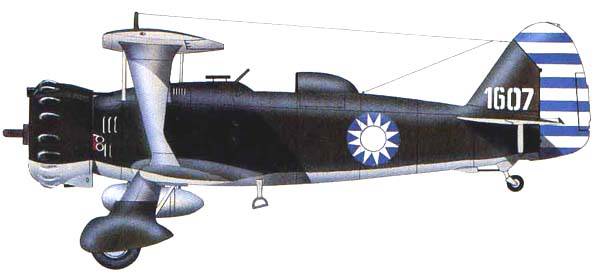
To show the unique combat survivability of this model, even at an early stage of its application, we present a simple fact: from the spring 1937 of the year to the spring of the 1939 year, despite active participation in the battles of the Spanish Civil War as a battlefield aircraft, none of the nearly two dozen Spanish nationalists Hs-Xnumx was not brought down by Republican forces.
However, despite the excellent success, this aircraft was considered a kind of transitional form and temporary ersatz before the mass production of the famous Ju-87, in connection with which the Junkers concern received for a number of reasons (one of which were huge empty aircraft manufacturing facilities) an absolute advantage in state order. . As a result, as early as April 1937, the large-scale production of Hs-123 was curtailed, and in October 1938 was finally discontinued, and although these attack aircraft were still in some Luftwaffe units, many of them were transferred to flight schools.
True, during the Polish 1939 campaign of 897, the German 36 bombers and attack aircraft were Hs-123, and they lost all 2 vehicles shot down, while Ju-87 units lost 31 aircraft (and these were 11% losses from the number of aggressors against Poland). In May-June, the 1940 of the 45 assault biplanes Hs-123 took an active part in the defeat of France, and in the spring of the 1941, the unit of these machines was used in the Balkan campaign. But, despite the constant successful combat practice, the leadership of the Luftwaffe decided to withdraw these planes from the composition of military aviation, considering these machines ideal for studying future pilots of the famous "pieces". The main drawbacks of this model were quite naturally indicated inadequate bomb load, short range and too weak weaponry.
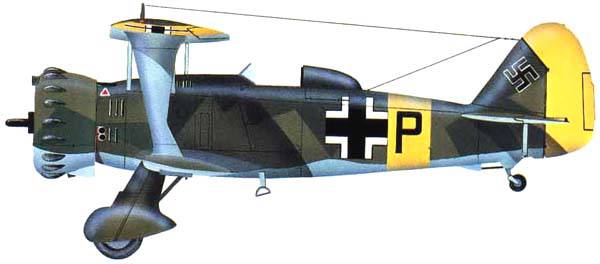
However, after the start of Operation Barbarossa, units of the Wehrmacht on the formed Eastern Front began to complain of a strong shortage of attack aircraft, despite the fact that the Soviet Air Force actively stormed their columns with many types of combat aircraft. In this regard, it was decided to resume the production of Hs-123A, in order to at least somehow saturate the Soviet-German front with attack aircraft. True, this did not happen due to many reasons, although many Hs-123 were withdrawn from flying schools and entered into the composition of the Luftwaffe combat units that fought in the Soviet Union.
Thus, since the summer of 1941, and especially since the spring of 1942, these seemingly primitive attack aircraft massively fought on almost all sectors of the Soviet-German front. Initially, as part of the invasion forces, Barbarossa launched the entire 22 Hs-123 from II.Schl./LG2, but then their number steadily increased. In the summer and autumn of 1941, these aircraft operated on the central and northern sectors of the Eastern Front, and then took part in the battle for Moscow.
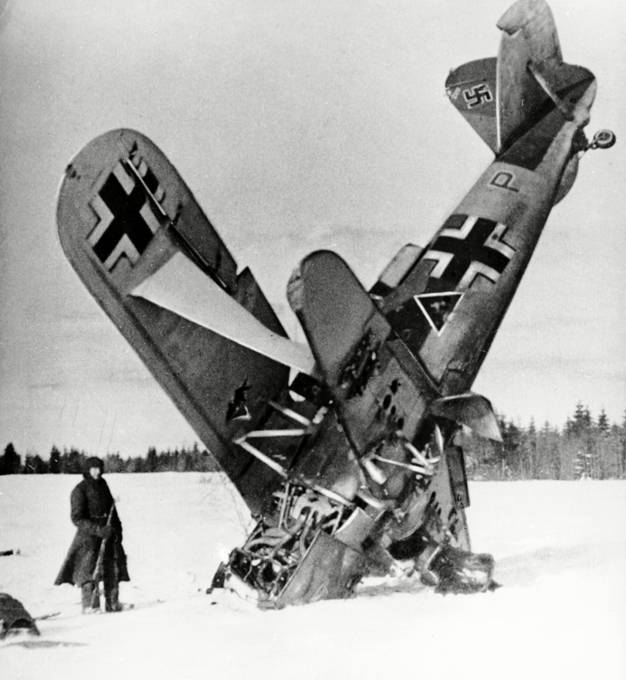
In January 1942, the remaining vehicles and the replenishment arrived were consolidated into a special part of 7./SchlG 1, and as part of this first assault wing in the Luftwaffe, they took part in the battles for Kharkiv and the Crimea. It may sound a bit strange, but in the summer and autumn of 1942, broken and damaged Hs-123 were searched for landfills all over Germany, which were urgently restored and sent to the Eastern Front.
During the fighting in Russia, the Germans found out that a very important advantage of these assault biplanes was their ability to operate from muddy ground airfields, which was impossible for most German aircraft. By the spring of 1943, the 4 of the Hs-123 squadron was already operating against the USSR. "Stalingrad" winter 1942-43 the Germans even came to the point that a number of Luftwaffe commanders again began to demand the resumption of production of these "unkillable" and universal machines, but the leaders of industry for a number of reasons again denied them that. Only the latest Hs-123 were transferred from flight schools and from the Balkan theater to the Eastern Front, where these outdated biplanes were fought in seemingly impossible conditions even before the summer of 1944 as part of II / SG2.
Based on the experience of fighting against the USSR in the autumn-winter 1941, the remaining aircraft were converted into a modification of the Hs-123B: they increased their armor, put a slightly more powerful engine BMW132K (960 hp), and the cabin was equipped with a closed lantern and heater, in order to provide the possibility for German pilots of comfortable combat missions in the harsh climate of continental Russia. According to some reports, on the Soviet-German front, some Hs-123 were permanently retrofitted with two 20-mm cannons, which were mounted at the base of the wings, in order to free the wing holders for the bombs.
Indeed, strange as it may seem, in the Luftwaffe front-line units Hs-123 was fought before the summer of 1943, even in the Battle of Kursk, and for counterguerrilla actions deep behind the front line they were used until the autumn of 1944. Another function of these German assault biplanes on the Eastern Front was their use as night bomber bombers, as well as their use in night fighter squadrons to counter the Soviet Po-2.
So, despite the extremely intensive use and long lifespan, these machines fought, in fact, until the end of the war, despite the fact that Hs-123 was released only 252 units. (7 prototypes, 16 pre-production and 229 serial copies), not many thousands. The last Hs-123 in the Wehrmacht carried out close reconnaissance, the delivery of food and ammunition to the surrounded German groups, and were also used as night bombers even in the autumn of 1944.
What can explain such a phenomenal "indestructibility" of this aircraft? In addition to the factors voiced above and affecting the combat survivability of the Hs-123, firstly, the highest build quality and a huge safety factor of the structure should be noted (no doubt, the tradition of the production of steam locomotives and irons affected). Secondly, small speed data, excellent stability during takeoff and landing, the ability to operate from any runways, simplicity and ease of control at the same time allowed us to avoid a huge number of non-combat losses (which, for example, the same Me-109 was famous for). Third, no matter how ridiculous this may seem, this supposedly primitive plane was an unexpectedly difficult target for poorly trained Soviet pilots (and these were the majority in the Red Army air force for a considerable period of war). Due to the very small load on the wing, the Hs-123 could literally turn around in the air "on the patch" and dodge the attack of a high-speed Soviet fighter (approximately the same tactics used by our aircraft of obsolete types, evading the attacks of "Messers").
In addition, despite the ceiling in 9000 m, Hs-123 operated on the Eastern Front mainly at ultra-low altitudes, and, "clinging to the ground", escaped fighter attacks, which, in turn, were afraid of crashing into the ground at such heights - for a much higher stall speed. A significant role in the survival of these biplanes was played by the extremely weak saturation of the Soviet formations with small-caliber anti-aircraft artillery, and this was the main means of struggle against attack aircraft.
Thus, a successful design and skillful tactics of action allowed this, in fact, created by an outdated scheme and released in a very small number of aircraft to actively fight almost until the very end of the war, even though there was no side-shooter for the defense of the rear hemisphere (which was considered almost catastrophic lack of early IL-2 series).
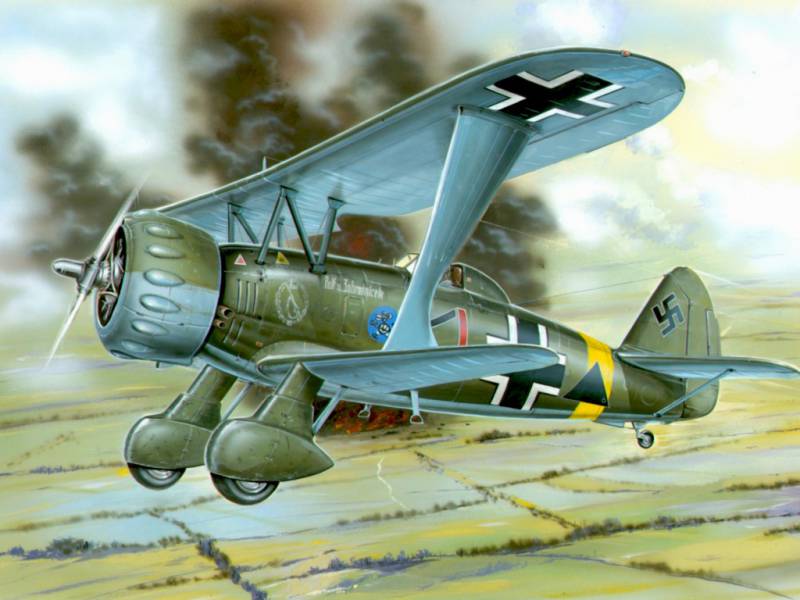
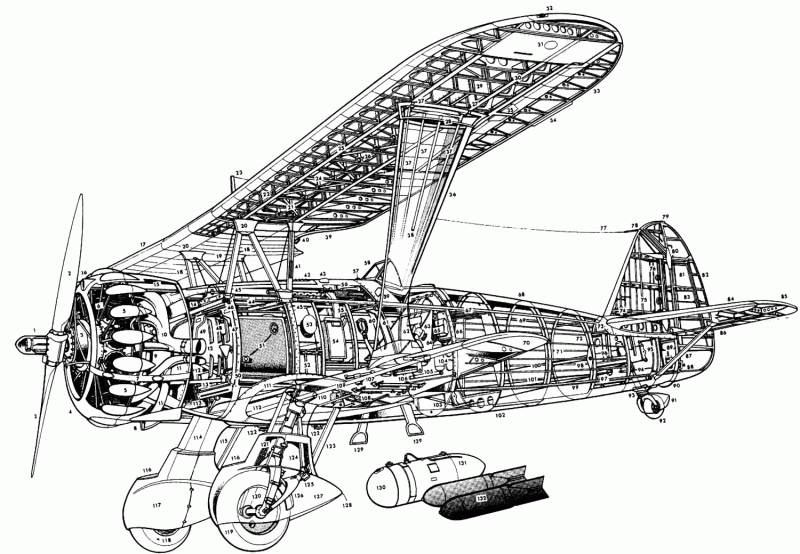
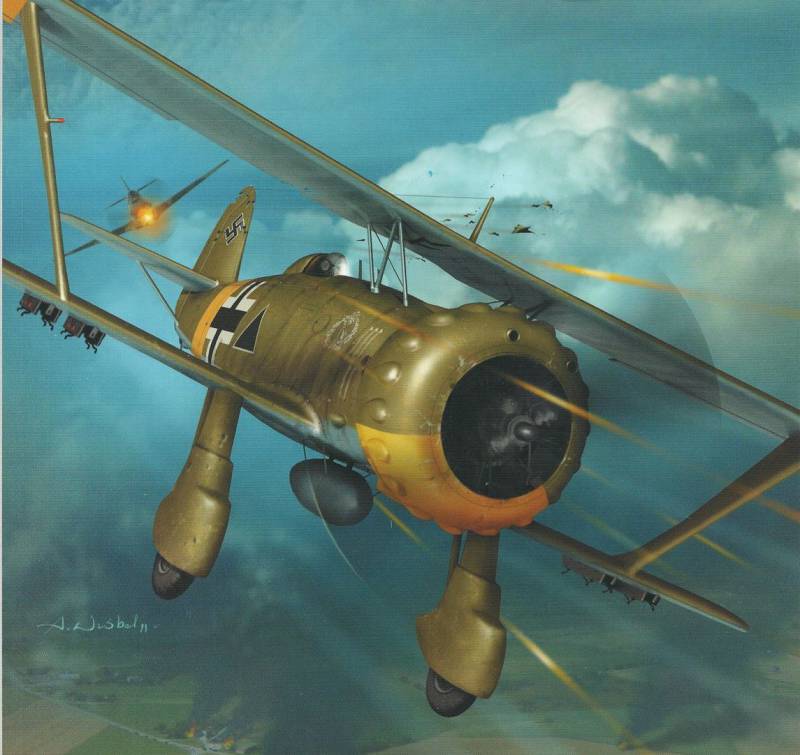
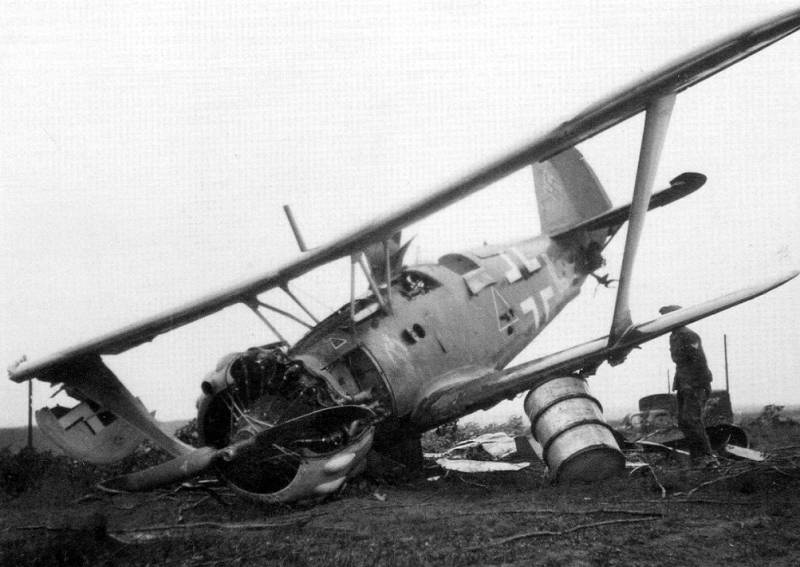
Information